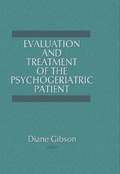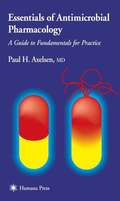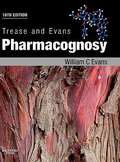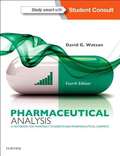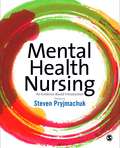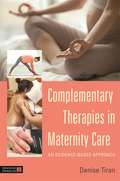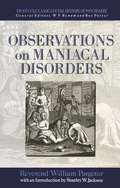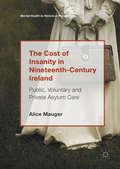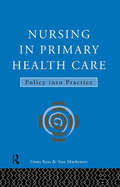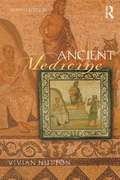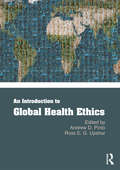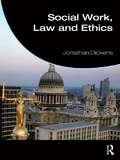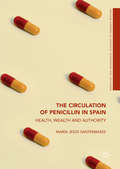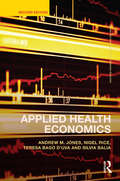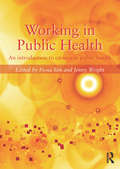- Table View
- List View
Evaluation and Treatment of the Psychogeriatric Patient
by Diane GibsonThis pertinent book assists occupational therapists and other health care providers in developing up-to-date psychogeriatric programs and understanding details of treating the cognitively impaired elderly. There exists a significant demand for occupational therapy in psychogeriatrics now. As the elderly population increases, especially elderly requiring rehabilitative care, the need for occupational therapy in psychogeriatrics will increase markably. Evaluation and Treatment of the Psychogeriatric Patient emphasizes the expertise of leading psychogeriatric occupational therapists, focusing on transitional programming, treating cognitive deficits, and recognizing the malignant cultural myths which continue to disenfranchise and denigrate the elderly.Appropriate diagnosis and management of the elderly population is vital to their ability to function independently. Through detailed, operationally useful descriptions of current geriatric day care hospitals and psychogeriatric transitional programs, this book will be an invaluable aid for social workers, nurses, geriatric counselors, and physical therapists. These helping professionals will be better equipped to develop up-to-date psychogeriatric programs and will better understand the details involved in treating the mentally impaired elderly.
Essentials Of Antimicrobial Pharmacology: A Guide To Fundamentals For Practice (PDF)
by Paul H. AxelsenPaul H. Axelsen concisely summarizes all the essential medical data concerning the leading antimicrobials used in fighting infectious diseases and clearly illustrates their mechanisms of action. The agents described range from antibacterial and antifungal to antiparasitic and antiviral agents, and include immunomodulators and immunizing agents. For each drug discussed, the book allows rapid access to the essential facts concerning its structure and mechanism of action, the spectrum of its activity, its pharmacokinetics, its adverse effects, and its resistance. This book provides medical students, physicians, and allied health professionals with rapid access to the core principles of antimicrobial pharmacology, and a foundation for decisions about the use of antimicrobials in daily practice.
Trease And Evans' Pharmacognosy (PDF)
by William Charles EvansThis encyclopedic reference work on pharmacognosy covers the study of those natural substances, principally plants, that find a use in medicine. Its popularity and longevity stem from the book's balance between classical (crude and powdered drugs' characterization and examination) and modern (phytochemistry and pharmacology) aspects of this branch of science, as well as the editor's recognition in recent years of the growing importance of complementary medicines, including herbal, homeopathic and aromatherapy. No other book provides such a wealth of detail. A reservoir of knowledge in a field where there is a resurgence of interest - plants as a source of drugs are of growing interest both in complementary medicine fields and in the pharmaceutical industry in their search for new 'lead compounds'. Dr Evans has been associated with the book for over 20 years and is a recognised authority in all parts of the world where pharmacognosy is studied, his knowledge and grasp of the subject matter is unique. Meticulously referenced and kept up to date by the editor, new contributors brought in to cover new areas. New chapter on 'Neuroceuticals'. Addition of many new compounds recently added to British Pharmacopoeia as a result of European harmonisation. Considers development in legal control and standardisation of plant materials previously regarded as 'herbal medicines'. More on the study of safety and efficacy of Chinese and Asian drugs. Quality control issues updated in line with latest guidelines (BP 2007).
Pharmaceutical Analysis: A Textbook For Pharmacy Students And Pharmaceutical Chemists (PDF)
by David G. WatsonPharmaceutical analysis forms a core part of any pharmacy programme, as well as being essential for pharmacology and medicinal chemistry courses. Pharmaceutical analysis determines the purity, concentration, active compounds, shelf life, rate of absorption in the body, identity, stability, rate of release etc. of a drug. Testing a pharmaceutical product involves a variety of analyses, and the analytical processes described in this book are used in industries as diverse as food, beverages, cosmetics, detergents, metals, paints, water, agrochemicals, biotechnological products and pharmaceuticals. The mathematics involved is notoriously difficult, but this much-praised textbook, now revised and updated for its fourth edition, guides a student through the complexities with clear writing and the author's expertise from many years' teaching pharmacy students. There is continuous learning reinforcement throughout the book by way of worked calculation examples and self-assessment test questions. Worked calculation examples Self-assessment Additional problems (self tests) Practical boxes Key points boxes New chapter on electrochemical biosensors. New chapter on the quality control of biotechnologically produced drugs. Extended chapter on molecular emission spectroscopy. Now comes with an e-book on StudentConsult. Self-assessment is interactive in the accompanying online e-book. 65 online animations show concepts such as ionization partitioning of drug molecules etc. ~
Mental Health Nursing: An Evidence Based Introduction
by Professor Steven PryjmachukDo you want to know how to help people with mental health problems? This book introduces you to the core skills and essential knowledge you need to deliver high-quality care. Mental Health Nursing is a practical, values- and evidence-based resource which will guide and support you through your pre-registration mental health nursing programme and into your own practice. Dedicated chapters focus on the major mental health problems, and are clearly structured so that you can quickly and easily identify what you want learn about helping people with, for example, depression, anxiety, psychosis, or acute mental health problems. The most up-to-date theories, as well as mental health policies and law from all four countries of the UK, are explained accessibly by experienced lecturers and nurse practitioners who show you through real-life case scenarios how you can use your newly-acquired knowledge and skills to deliver high-quality care yourself. You will also be encouraged - through regular reflection and discussion points - to see things with a critical eye and to engage in and drive on the debates that make mental health nursing such an exciting field to be studying and working in. Set within a framework which emphasises and makes clear the core skills, values and knowledge-base you need to become capable mental health nurse, you will find this book a vital companion as you progress through your studies and onto helping people confidently in everyday life.
Mental Health Nursing: An Evidence Based Introduction
by Dr Steven PryjmachukDo you want to know how to help people with mental health problems? This book introduces you to the core skills and essential knowledge you need to deliver high-quality care. Mental Health Nursing is a practical, values- and evidence-based resource which will guide and support you through your pre-registration mental health nursing programme and into your own practice. Dedicated chapters focus on the major mental health problems, and are clearly structured so that you can quickly and easily identify what you want learn about helping people with, for example, depression, anxiety, psychosis, or acute mental health problems. The most up-to-date theories, as well as mental health policies and law from all four countries of the UK, are explained accessibly by experienced lecturers and nurse practitioners who show you through real-life case scenarios how you can use your newly-acquired knowledge and skills to deliver high-quality care yourself. You will also be encouraged - through regular reflection and discussion points - to see things with a critical eye and to engage in and drive on the debates that make mental health nursing such an exciting field to be studying and working in. Set within a framework which emphasises and makes clear the core skills, values and knowledge-base you need to become capable mental health nurse, you will find this book a vital companion as you progress through your studies and onto helping people confidently in everyday life.
Complementary Therapies in Maternity Care: An Evidence-Based Approach
by Denise TiranThe complete textbook on complementary therapies in maternity care, this book addresses how midwives and other birth professionals can use or advise on complementary therapies for pregnant, labouring and new mothers. Almost 90% of women may be using complementary therapies during pregnancy and birth, and increasingly midwives and doulas incorporate therapies into their care of women, so it is vital that they and other professionals in the maternity care field are aware of safe and appropriate use based on contemporary evidence. Therapies covered include acupuncture, herbal medicine, homeopathy, aromatherapy, reflexology, yoga, massage and hypnosis. This complete guide to complementary therapies in pregnancy and childbirth covers safety, effectiveness, evidence, benefits and risks, legal, ethical and professional issues based on accurate and up-to-date research.
Observations on Maniacal Disorder
by Pargeter Stanley JacksonFirst Published in 1989. Routledge is an imprint of Taylor & Francis, an informa company.
Observations on Maniacal Disorder
by Pargeter Stanley JacksonFirst Published in 1989. Routledge is an imprint of Taylor & Francis, an informa company.
The Cost of Insanity in Nineteenth-Century Ireland: Public, Voluntary and Private Asylum Care
by Alice MaugerThis open access book is the first comparative study of public, voluntary and private asylums in nineteenth-century Ireland. Examining nine institutions, it explores whether concepts of social class and status and the emergence of a strong middle class informed interactions between gender, religion, identity and insanity. It questions whether medical and lay explanations of mental illness and its causes, and patient experiences, were influenced by these concepts. The strong emphasis on land and its interconnectedness with notions of class identity and respectability in Ireland lends a particularly interesting dimension. The book interrogates the popular notion that relatives were routinely locked away to be deprived of land or inheritance, querying how often “land grabbing” Irish families really abused the asylum system for their personal economic gain. The book will be of interest to scholars of nineteenth-century Ireland and the history of psychiatry and medicine in Britain and Ireland.
The Cost of Insanity in Nineteenth-Century Ireland: Public, Voluntary and Private Asylum Care
by Alice MaugerThis open access book is the first comparative study of public, voluntary and private asylums in nineteenth-century Ireland. Examining nine institutions, it explores whether concepts of social class and status and the emergence of a strong middle class informed interactions between gender, religion, identity and insanity. It questions whether medical and lay explanations of mental illness and its causes, and patient experiences, were influenced by these concepts. The strong emphasis on land and its interconnectedness with notions of class identity and respectability in Ireland lends a particularly interesting dimension. The book interrogates the popular notion that relatives were routinely locked away to be deprived of land or inheritance, querying how often “land grabbing” Irish families really abused the asylum system for their personal economic gain. The book will be of interest to scholars of nineteenth-century Ireland and the history of psychiatry and medicine in Britain and Ireland.
Nursing in Primary Health Care: Policy into Practice
by Ann MacKenzie Fiona RossThe role and scope of nursing in primary health care is continually evolving as a result of changes in society. This book explores current issues from the perspective of nursing, showing how policy informs practice. The topics covered include: * health needs profiling* assessment * interprofessional work * quality of care * family carers * new nursing roles in primary health careThe book is suitable for practioners in primary health care, students doing diploma, degree and postgraduate courses in nursing and health studies, and also post-registration courses. Nursing in Primary Care draws on research and examples from practice to encourage a questioning approach to policy information and the consequences of its implementation.
Nursing in Primary Health Care: Policy into Practice
by Ann MacKenzie Fiona RossThe role and scope of nursing in primary health care is continually evolving as a result of changes in society. This book explores current issues from the perspective of nursing, showing how policy informs practice. The topics covered include: * health needs profiling* assessment * interprofessional work * quality of care * family carers * new nursing roles in primary health careThe book is suitable for practioners in primary health care, students doing diploma, degree and postgraduate courses in nursing and health studies, and also post-registration courses. Nursing in Primary Care draws on research and examples from practice to encourage a questioning approach to policy information and the consequences of its implementation.
Ancient Medicine
by Vivian NuttonThe first edition of Ancient Medicine was the most complete examination of the medicine of the ancient world for a hundred years. The new edition includes the key discoveries made since the first edition, especially from important texts discovered in recent finds of papyri and manuscripts, making it the most comprehensive and up-to-date survey available. Vivian Nutton pays particular attention to the life and work of doctors in communities, links between medicine and magic, and examines the different approaches to medicine across the ancient world. The new edition includes more on Rufus and Galen as well as augmented information on Babylonia, Hellenistic medicine and Late Antiquity. With recently discovered texts made accessible for the first time, and providing new evidence, this broad exploration challenges currently held perspectives, and proves an invaluable resource for students of both classics and the history of medicine.
Ancient Medicine
by Vivian NuttonThe first edition of Ancient Medicine was the most complete examination of the medicine of the ancient world for a hundred years. The new edition includes the key discoveries made since the first edition, especially from important texts discovered in recent finds of papyri and manuscripts, making it the most comprehensive and up-to-date survey available. Vivian Nutton pays particular attention to the life and work of doctors in communities, links between medicine and magic, and examines the different approaches to medicine across the ancient world. The new edition includes more on Rufus and Galen as well as augmented information on Babylonia, Hellenistic medicine and Late Antiquity. With recently discovered texts made accessible for the first time, and providing new evidence, this broad exploration challenges currently held perspectives, and proves an invaluable resource for students of both classics and the history of medicine.
An Introduction to Global Health Ethics
by Andrew D. Pinto Ross E. UpshurThe field of global health is expanding rapidly. An increasing number of trainees are studying and working with marginalized populations, often within low and middle-income countries. Such endeavours are beset by ethical dilemmas: mitigating power differentials, addressing cultural differences in how health and illness are viewed, and obtaining individual and community consent in research. This introductory textbook supports students to understand and work through key areas of concern, assisting them in moving towards a more critical view of global health practise. Divided into two sections covering the theory and practice of global health ethics, the text begins by looking at definitions of global health and the field’s historical context. It draws on anti-colonial perspectives concepts, developing social justice and solidarity as key principles to guide students. The second part focuses on ethical challenges students may face in clinical experiences or research. Topics such as working with indigenous communities, the politics of global health governance, and the ethical challenges of advocacy are explored using a case study approach. An Introduction to Global Health Ethics includes recommended resources and further readings, and is ideal for students from a range of disciplines – including public health, medicine, nursing, law and development studies – who are undertaking undergraduate and graduate courses in ethics or placements overseas.
An Introduction to Global Health Ethics
by Andrew D. Pinto Ross E. UpshurThe field of global health is expanding rapidly. An increasing number of trainees are studying and working with marginalized populations, often within low and middle-income countries. Such endeavours are beset by ethical dilemmas: mitigating power differentials, addressing cultural differences in how health and illness are viewed, and obtaining individual and community consent in research. This introductory textbook supports students to understand and work through key areas of concern, assisting them in moving towards a more critical view of global health practise. Divided into two sections covering the theory and practice of global health ethics, the text begins by looking at definitions of global health and the field’s historical context. It draws on anti-colonial perspectives concepts, developing social justice and solidarity as key principles to guide students. The second part focuses on ethical challenges students may face in clinical experiences or research. Topics such as working with indigenous communities, the politics of global health governance, and the ethical challenges of advocacy are explored using a case study approach. An Introduction to Global Health Ethics includes recommended resources and further readings, and is ideal for students from a range of disciplines – including public health, medicine, nursing, law and development studies – who are undertaking undergraduate and graduate courses in ethics or placements overseas.
Social Work, Law and Ethics
by Jonathan DickensLaw and ethics are two vital aspects of social work – all social workers need to practise according to the law and their codes of ethics and conduct. However, the relationship between the law and social work values and ethics is not without its tensions and this book takes a problem-based approach to explore the dilemmas and challenges that can arise. The first part of the book sets out frameworks for thinking about the law and ethics, and how they relate to social work. It also introduces some of the big philosophical and sociological questions about the purposes of law and of ethics and how they relate to society more generally. In the second part, the book explores a series of areas where profound dilemmas arise – such as end-of-life decisions, respecting peoples’ choices but ensuring their safety and that of others, responsibility and blame, making allowance for different cultural traditions and breaking confidentiality. In each of the problem-based chapters, this accessible text: outlines the relevant law discusses court judgments in leading cases considers the implications of different ethical frameworks pulls out key ethical questions and challenges for social work. Social Work, Law and Ethics highlights what the law says and what it offers, what ethical principles are at stake, and what these imply for social work policy and practice. In this way, it uses real-life scenarios to analyse the dynamic interactions of social work, law and ethics. It is essential reading for all social work students.
Social Work, Law and Ethics
by Jonathan DickensLaw and ethics are two vital aspects of social work – all social workers need to practise according to the law and their codes of ethics and conduct. However, the relationship between the law and social work values and ethics is not without its tensions and this book takes a problem-based approach to explore the dilemmas and challenges that can arise. The first part of the book sets out frameworks for thinking about the law and ethics, and how they relate to social work. It also introduces some of the big philosophical and sociological questions about the purposes of law and of ethics and how they relate to society more generally. In the second part, the book explores a series of areas where profound dilemmas arise – such as end-of-life decisions, respecting peoples’ choices but ensuring their safety and that of others, responsibility and blame, making allowance for different cultural traditions and breaking confidentiality. In each of the problem-based chapters, this accessible text: outlines the relevant law discusses court judgments in leading cases considers the implications of different ethical frameworks pulls out key ethical questions and challenges for social work. Social Work, Law and Ethics highlights what the law says and what it offers, what ethical principles are at stake, and what these imply for social work policy and practice. In this way, it uses real-life scenarios to analyse the dynamic interactions of social work, law and ethics. It is essential reading for all social work students.
The Circulation of Penicillin in Spain: Health, Wealth and Authority
by María Jesús SantesmasesThis book reconstructs the early circulation of penicillin in Spain, a country exhausted by civil war (1936–1939), and oppressed by Franco’s dictatorship. Embedded in the post-war recovery, penicillin’s voyages through time and across geographies – professional, political and social – were both material and symbolic. This powerful antimicrobial captivated the imagination of the general public, medical practice, science and industry, creating high expectations among patients, who at times experienced little or no effect. Penicillin’s lack of efficacy against some microbes fueled the search for new wonder drugs and sustained a decades-long research agenda built on the post-war concept of development through scientific and technological achievements. This historical reconstruction of the social life of penicillin between the 1940s and 1980s – through the dictatorship to democratic transition – explores political, public, medical, experimental and gender issues, and the rise of antibiotic resistance.
The Circulation of Penicillin in Spain: Health, Wealth and Authority
by María Jesús SantesmasesThis book reconstructs the early circulation of penicillin in Spain, a country exhausted by civil war (1936–1939), and oppressed by Franco’s dictatorship. Embedded in the post-war recovery, penicillin’s voyages through time and across geographies – professional, political and social – were both material and symbolic. This powerful antimicrobial captivated the imagination of the general public, medical practice, science and industry, creating high expectations among patients, who at times experienced little or no effect. Penicillin’s lack of efficacy against some microbes fueled the search for new wonder drugs and sustained a decades-long research agenda built on the post-war concept of development through scientific and technological achievements. This historical reconstruction of the social life of penicillin between the 1940s and 1980s – through the dictatorship to democratic transition – explores political, public, medical, experimental and gender issues, and the rise of antibiotic resistance.
Applied Health Economics
by Andrew M. Jones Nigel Rice Teresa Bago D'Uva Silvia BaliaThe first edition of Applied Health Economics did an expert job of showing how the availability of large scale data sets and the rapid advancement of advanced econometric techniques can help health economists and health professionals make sense of information better than ever before. This second edition has been revised and updated throughout and includes a new chapter on the description and modelling of individual health care costs, thus broadening the book’s readership to those working on risk adjustment and health technology appraisal. The text also fully reflects the very latest advances in the health economics field and the key journal literature. Large-scale survey datasets, in particular complex survey designs such as panel data, provide a rich source of information for health economists. They offer the scope to control for individual heterogeneity and to model the dynamics of individual behaviour. However, the measures of outcome used in health economics are often qualitative or categorical. These create special problems for estimating econometric models. The dramatic growth in computing power over recent years has been accompanied by the development of methods that help to solve these problems. The purpose of this book is to provide a practical guide to the skills required to put these techniques into practice. Practical applications of the methods are illustrated using data on health from the British Health and Lifestyle Survey (HALS), the British Household Panel Survey (BHPS), the European Community Household Panel (ECHP), the US Medical Expenditure Panel Survey (MEPS) and Survey of Health, Ageing and Retirement in Europe (SHARE). There is a strong emphasis on applied work, illustrating the use of relevant computer software with code provided for Stata. Familiarity with the basic syntax and structure of Stata is assumed. The Stata code and extracts from the statistical output are embedded directly in the main text and explained at regular intervals. The book is built around empirical case studies, rather than general theory, and the emphasis is on learning by example. It presents a detailed dissection of methods and results of some recent research papers written by the authors and their colleagues. Relevant methods are presented alongside the Stata code that can be used to implement them and the empirical results are discussed at each stage. This text brings together the theory and application of health economics and econometrics, and will be a valuable reference for applied economists and students of health economics and applied econometrics.
Applied Health Economics
by Andrew M. Jones Nigel Rice Teresa Bago D'Uva Silvia BaliaThe first edition of Applied Health Economics did an expert job of showing how the availability of large scale data sets and the rapid advancement of advanced econometric techniques can help health economists and health professionals make sense of information better than ever before. This second edition has been revised and updated throughout and includes a new chapter on the description and modelling of individual health care costs, thus broadening the book’s readership to those working on risk adjustment and health technology appraisal. The text also fully reflects the very latest advances in the health economics field and the key journal literature. Large-scale survey datasets, in particular complex survey designs such as panel data, provide a rich source of information for health economists. They offer the scope to control for individual heterogeneity and to model the dynamics of individual behaviour. However, the measures of outcome used in health economics are often qualitative or categorical. These create special problems for estimating econometric models. The dramatic growth in computing power over recent years has been accompanied by the development of methods that help to solve these problems. The purpose of this book is to provide a practical guide to the skills required to put these techniques into practice. Practical applications of the methods are illustrated using data on health from the British Health and Lifestyle Survey (HALS), the British Household Panel Survey (BHPS), the European Community Household Panel (ECHP), the US Medical Expenditure Panel Survey (MEPS) and Survey of Health, Ageing and Retirement in Europe (SHARE). There is a strong emphasis on applied work, illustrating the use of relevant computer software with code provided for Stata. Familiarity with the basic syntax and structure of Stata is assumed. The Stata code and extracts from the statistical output are embedded directly in the main text and explained at regular intervals. The book is built around empirical case studies, rather than general theory, and the emphasis is on learning by example. It presents a detailed dissection of methods and results of some recent research papers written by the authors and their colleagues. Relevant methods are presented alongside the Stata code that can be used to implement them and the empirical results are discussed at each stage. This text brings together the theory and application of health economics and econometrics, and will be a valuable reference for applied economists and students of health economics and applied econometrics.
Working in Public Health: An introduction to careers in public health
by Fiona Sim Jenny WrightWhat can you contribute to improving and protecting the health of your community? Public health is becoming an increasingly central area of healthcare practice and people working in public health come from a wide range of disciplines and backgrounds. This practical and accessible book maps out the range of exciting and varied options open to people considering a career in public health, and provides helpful information on how to get there, either as a fully-fledged specialist or in an operational practitioner role. Designed especially for those wanting to learn about public heath, it looks at public health work in a range of settings, from health services to the commercial sector, and in a range of different roles, from health protection to public health intelligence. Numerous personal accounts and case studies from highly experienced practitioners and specialists, as well as those new to their roles, illustrate what their roles involve and how have they had an impact on improving health and reducing inequality. This is the ideal book for anyone interested in putting public health at the centre of their working lives.
Working in Public Health: An introduction to careers in public health
by Fiona Sim Jenny WrightWhat can you contribute to improving and protecting the health of your community? Public health is becoming an increasingly central area of healthcare practice and people working in public health come from a wide range of disciplines and backgrounds. This practical and accessible book maps out the range of exciting and varied options open to people considering a career in public health, and provides helpful information on how to get there, either as a fully-fledged specialist or in an operational practitioner role. Designed especially for those wanting to learn about public heath, it looks at public health work in a range of settings, from health services to the commercial sector, and in a range of different roles, from health protection to public health intelligence. Numerous personal accounts and case studies from highly experienced practitioners and specialists, as well as those new to their roles, illustrate what their roles involve and how have they had an impact on improving health and reducing inequality. This is the ideal book for anyone interested in putting public health at the centre of their working lives.
